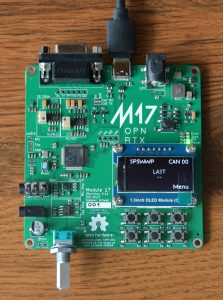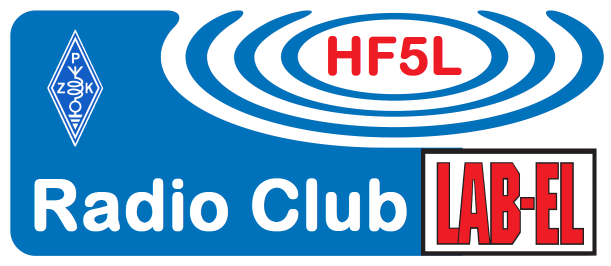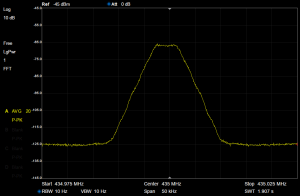Many have heard of it, but few know what it is about. And it’s worth knowing. The M17 project is often called the future of digital radio in the global amateur radio community. For Poles, it is a reason to be proud, because the idea was created at the turn of 2018 and 2019 in one of the Warsaw amateur radio clubs. The initiator of the project was Wojtek Kaczmarski SP5WWP.
Let’s start with the basics: M17 is the new standard in digital radio. What makes this mode different from existing solutions? First of all, openness – M17 is a free specification of the digital communication mode: codec, protocol stack, modulation parameters, hardware documentation – all this is 100% open source.
A noteworthy feature of the M17 is the lack of the need to register and assign users an ID (as in the DMR mode, popular not only in Poland). In M17, a user’s identifier is his callsign. The M17 additionally offers data services, including text messages and positioning data. The project is not dependent on any manufacturer of amateur radio equipment. This standard facilitate connections across other digital voice modes and Internet-connected networks. M17 is the only one that supports connecting reflectors using the IPv6 Internet protocol.
The entire M17 protocol specification is released under the GNU General Public License v. 2.0. Protocol documentation is available at https://spec.m17project.org/ and on GitHub https://github.com/M17-Project, where there are also diagrams and designs of devices supporting the protocol.
Shortly after the start of the M17 project, the OpenRTX project https://openrtx.org/#/ was created, close in concept. A group of amateur radio operators from Italy decided to prepare completely open, alternative software (firmware) for handheld transceivers such as the TYT MD-380 from scratch. After a year of intensive work, OpenRTX offered users not only analog FM, but also M17. In September 2023, the WPSD project – W0CHP’s Pi-Star Dashboard – joined the M17 group. As software for hotspots, based on a solution created a few years ago by Andy MW0MWZ, but subject to continuous development, it quickly gained great popularity. There are over 150 M17 reflectors in the world. The M17 protocol specification has been implemented in popular software such as MMDVM, SDRAngel, OpenWebRX and SDR++.
M17 is more than just a communications protocol. This is an entire ecosystem that includes radio devices, but also those that do not use radio waves. The project also develops numerous software solutions, such as WPSD, DroidStar, mvoice and the M17 implementation in GNU Radio. There are many implementations that allow radio amateurs to use this open standard in a wide range of devices. It is worth mentioning that the M17 mode has been successfully tested over the QO-100 geostationary satellite.
How to start with M17? Due to the open source nature of the project, there will certainly be new opportunities to use the M17 in amateur radio practice. A list of start options can be found on the project website: https://m17project.org/get-started.
If you are using an MMDVM hotspot with your usual DMR/DSTAR/etc., you already have the appropriate radio interface. Such a hotspot, if recently updated, is capable transmitying and receiving M17. You can either use it as a classic access point using Pi-Star, or turn it into a full QRP M17 radio using the M17Client software.
If you do not have an MMDVM device or are looking for a simpler setup, you can use your computer as an M17 modem. The m17-tools toolkit (with m17-mod-gui UI) https://github.com/M17-Project/m17-tools contains everything you need in terms of software. On the hardware side, you need an FM transceiver that supports 9600 baud and a second sound card. If you want to avoid the wiring and control (CAT) problem, you can use DigiRig. It is an inexpensive, open-source all-in-one soundcard and remote control interface, intended for amateur radio (https://digirig.net/).
Another solution is to use the Module17 modem. This is a self-contained M17 modem that can be used without a computer. The built-in STM32 microcontroller handles the vocoder, 4FSK modulation and demodulation, and user interface. An external microphone is used as the audio input, and a loudspeaker is used as the output (classic Kenwood design with two mini-jack sockets). It is worth noting that the M17-R0.1E module is already available on the AliExpress platform: https://a.aliexpress.com/_EIhpLJX.

However, the best solution is to have a portable radio with an M17. OpenRTX is a modular, open source software designed for digital radios such as the MD-380 or the Radioddity GD-77. It allows you to add several features, including M17 support. Minor hardware modifications to the devices are needed.
The DroidStar Android application is used to connect to various types of reflectors, including DMR, DSTAR, C4FM, etc. Since the very beginning, it offered M17 support, so it is possible to connect to M17 reflectors even without a working radio.
The M17 team didn’t just create a new digital mode and implement it on existing hardware. Work is also underway on an entirely new hardware platform: OpenHT. It is a self-contained, handheld SDR transciever for the 70 and 13 cm bands (duobander). The device is intended to handle virtually every type of modulation that exists. While the initial focus was on M17, FreeDV and analog FM, its open source nature (both hardware and software) allows anyone to contribute and implement other modulation modes. More information can be found here: https://m17project.org/news/openht-a-breakthrough-in-ham-radio.
On our website hf5l.pl we will try to update the progress of the M17 project and share the practical experiences of users. We invite you to discuss and share your experiments with M17.
The M17 project was written about, among others, in: Świat Radio 11/2020, CQ DL 12/2023, Wikipedia (in eight languages). The M17 team posts regular updates on Twitter, Mastodon and LinkedIn.
ATTENTION!
The M17 Foundation invites you to a technical conference on, among others, M17 and open-source topics in amateur radio. Due to its international nature, the entire event will be held in English. Free admission.
Date: September 6-7, 2025 (first weekend of the month)
Location: Officer’s Casino in the Modlin Fortress (Poland, Nowy Dwór Mazowiecki), Ledóchowskiego street 160
Registration form for speakers and exhibitors available at the link below:
https://m17foundation.org/m17-conference-2025/


Number of Comments: 1
Witam i dziękuję za wkład. Jak piszesz, do obsługi M17 można wykorzystać hotspot MMDVM z WPSD/Pi-Star i aktualnym firmware (tutaj 1.6.1). Nigdzie nie jest opisane, jak nawiązać połączenie z DMR TRX (tutaj urządzenia Anytone) do M17? Hotspot pokazuje aktywne połączenie z siecią M17, ale jak przeprowadzić QSO? Nie można skonfigurować M17 w bramce DMR. Co muszę ustawić w Anytone? Skąd hotspot bierze informację, że chcę korzystać z sieci M17?
Hello and thank you for the contribution. As you write, an MMDVM hotspot with WPSD / Pi-Star and current firmware (here 1.6.1) can be used to use M17. What is not described anywhere is how do I establish the connection from the DMR TRX (here Anytone devices) to the M17? The hotspot shows an active connection to the M17 network, but how do I conduct a QSO? M17 cannot be configured in the DMR Gateway. What do I have to set on the Anytone? Where does the hotspot get the information that I want to use the M17 network?
73 de Steffen /DM2DX